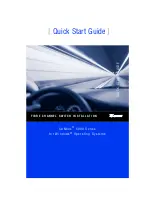
Chapter 6 Troubleshooting
53
Chapter 6
Troubleshooting
This chapter describes how to troubleshoot your switch. This document describes troubleshooting mostly from a
hardware perspective. You can perform more in-depth troubleshooting on these devices using the software tools
available with the switches, including the full-featured console interface, the built-in web browser interface, and
IMC, the SNMP-based network management tool, or Aruba AirWave.
This chapter describes the following:
•
Basic troubleshooting tips (see
•
Diagnosing with the LEDs (see
)
•
Hardware diagnostic tests (see
•
Downloading new software to the switch (see
Downloading new switch software
•
Hewlett Packard Enterprise Customer Support Services (see
Hewlett Packard Enterprise Customer
)
Basic troubleshooting tips
Most problems are caused by the following situations. Check for these items first when starting your
troubleshooting:
•
Faulty or loose cables.
Look for loose or obviously faulty connections. If the cables appear to be OK, make
sure the connections are snug. If that does not correct the problem, try a different cable.
•
Non-standard cables.
Non-standard and miswired cables may cause network collisions and other network
problems, and can seriously impair network performance. Use a new correctly-wired cable or compare your
cable to the cable in chapter 6,
Cabling and technology information
for pinouts and correct cable wiring.
•
Transceiver type not supported by port.
A 1GBase-T or 10GBase-T transceiver is installed in a port that
does not support the transceiver type. Only the first two rows of ports in Aruba 48YBC switches support
1GBase-T (J8177D) transceivers. Only the first six ports in rows 1 and 2 in Aruba 48YBC switches support
10GBase-T transceivers. For more information, see:
◦
“1GBase-T (J8177D) transceiver support restrictions in the 48-port 8325 switches”
◦
“10GBase-T (JL563A) transceiver support restrictions in the 48-port 8325 switches”
•
Improper network topologies.
It is important to make sure you have a valid network topology. Common
topology faults include excessive cable lengths. If you have network problems after recent changes to the
network, change back to the previous topology. If you no longer experience the problems, the new topology is
probably at fault.
In addition, you should make sure that your network topology contains
no data path loops
. Between any two
end nodes, there should be only one active cabling path at any time. Data path loops can cause broadcast
storms that will severely impact your network performance.
For your switch, if you want to build redundant paths between important nodes in your network to provide some
fault tolerance, you should enable
Spanning Tree Protocol
support on the switch. This ensures that only one
of the redundant paths is active at any time, thus avoiding data path loops. Spanning Tree can be enabled
through the switch console or the web browser interface. For more information on Spanning Tree, see the
Layer 2 Bridging Guide
for your switch at
Содержание Aruba 8325 Series
Страница 1: ...Aruba 8325 Switch Series Installation and Getting Started Guide Published June 2022 Edition 3 ...
Страница 6: ...6 Aruba 8325 Switch Installation and Getting Started Guide ...
Страница 8: ...8 Aruba 8325 Switch Installation and Getting Started Guide ...
Страница 28: ...28 Aruba 8325 Switch Installation and Getting Started Guide ...
Страница 46: ...46 Aruba 8325 Switch Installation and Getting Started Guide ...
Страница 52: ...52 Aruba 8325 Switch Installation and Getting Started Guide ...
Страница 60: ...60 Aruba 8325 Switch Installation and Getting Started Guide ...
Страница 68: ...68 Aruba 8325 Switch Installation and Getting Started Guide ...
















































